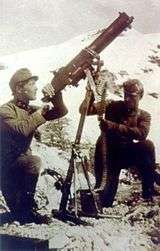Steyr M1912
| Steyr M1912 | |
|---|---|
|
Steyr M1912 with box and magazine charger clip of 9×23mm Steyr ammunition | |
| Type | Semi-automatic handgun, Machine pistol |
| Place of origin |
|
| Service history | |
| Used by | |
| Wars | |
| Production history | |
| Designer | Karel Krnka |
| Manufacturer | Steyr |
| Produced | 1912–1945 |
| Number built | Up to 300,000 |
| Variants | Doppelpistole M.12 |
| Specifications | |
| Weight | 1.2 kg (2.6 lb) |
| Length | 216 mm (8.5 in) |
| Barrel length | 128 mm (5.0 in) |
|
| |
| Cartridge | |
| Action | Recoil operated |
| Muzzle velocity | 1,120 ft/s (341 m/s)[a] |
| Effective firing range | 50 m (160 ft) |
| Feed system | 8-round integral magazine, fed by stripper clips |
| Sights | Iron sights |
The Steyr M1912, also known as the Steyr-Hahn, is a semi-automatic pistol developed in 1911 by the Austrian firm Steyr Mannlicher and designed by Karel Krnka, based on the mechanism of the Roth–Steyr M1907. It was developed for the Austro-Hungarian Army and adopted in 1912 as the M1912. It was in service in a limited capacity for the Wehrmacht until the end of World War II.
The M1912 was originally chambered for the 9mm Steyr round, but after the annexation of Austria by Germany in 1938 the M1912 was taken into Wehrmacht service and about 60,000 were rechambered in 9mm Parabellum and remained in service until the end of the war.
History
The M1912 was developed as the Model 1911 as a military weapon, but it was not accepted until 1914 as the M12. It was originally issued to the Austrian Landwehr while common army units were issued Roth–Steyr M1907 handguns and Rast & Gasser M1898 revolvers. Orders were also placed by Chile and Romania. During World War I, Austria-Hungary experienced shortages of handguns and production of the M1912 was increased. Germany also placed an order for 10,000 of the type (not to be confused with the later incorporation of the M1912 by the Wehrmacht in World War II), chambered for the 9mm Steyr cartridge.
After World War I, a commercial model (The Steyr M1911) was produced and was quite popular with army officers, but Steyr had to rely on foreign exports to sustain production. After the annexation of Austria by Germany, the Wehrmacht placed a small order (60,000+) chambered in 9mm Parabellum. In German service, its official designation was 9mm P12(Ö)('Ö' for Österreichische, "Austrian"). Pistols in Wehrmacht service were distinguished by the 08 stamp on the slide and the Wehrmachtadler ("Wehrmacht Eagle") emblem above the trigger.
The M1912 is a dependable and consistent performer, its operating system being generally of good quality was able to endure the adverse conditions of trench warfare during World War I.
Design details

The Steyr M1912 handgun is operated by a system of short recoil, the barrel unlocking from the slide by rotation. As the pistol is being fired and the recoil of the pistol is in motion, a lug and groove system around the barrel rotate the barrel 20° until a lug hits a stop wedge and holds the barrel while the slide is free to continue its rearward travel, the extractor claw withdrawing the spent casing against the breech face of the slide until the casing strikes the ejector and departs the weapon via the ejection and loading port. Shortly after ejection the slide's rearward travel is arrested by the compressed recoil spring and the abutment of mated surfaces of the slide and frame. The recoil spring is now free to return its stored energy to the cycle of the weapon by beginning to return the slide forward.
As the return spring returns the slide forward, the breech face strips a round from the magazine into the chamber and the locking system engages the barrel and locks it with the slide in the battery position. A safety lever on the left side of the frame can be engaged by turning it into a notch on the slide to immobilize the slide. A disconnector system will also prevent the weapon from firing until the whole action is fully closed.
Although the magazine is situated in the grip, it is integral with the weapon and is loaded from above using eight-round stripper clips. To load, the slide is pulled back to expose the action, the clip is inserted along the guides and the rounds pushed into the magazine.The metal strip is then discarded.
As with the majority of pistols with integral magazines, a lever can be used disengage the magazine catch in order to eject the magazine load.
Doppelpistole M.12 doubled machinegun
A dual mount stock was also available that converted the M1912 into a double barrel submachine gun known as the Doppelpistole M.12.[1]
Notes
| a. | Muzzle velocity of 9mm Parabellum cartridge. |
References
- ↑ Peter Jung (1995). Die K.u.K. Streitkräfte im Ersten Weltkrieg 1914-1918: die militärischen Formationen in der Türkei und im mittleren Osten : die Faustfeuerwaffen. Verlagsbuchhandlung Stöhr. p. 66. Retrieved 29 June 2013. - Im Laufe des Krieges wurden spezielle Versionen der M. 12 entwickelt, und zwar die die M. 12/16 mit Dauerfeuereinrichtung sowie die „Doppelpistole" M.12, die aus zwei gekoppelten M.12/ 16 mit Anschlagschaft bestand.
- McNab, Chris (2002). Twentieth-Century Small Arms. Hoo, Rochester, Kent: Grange Books. ISBN 978-1-84013-381-3.
External links
| Wikimedia Commons has media related to Steyr-Hahn. |
- Steyr-Hahn Pistol Commercial Model 1911 and Army Model 1912 (English)
- Doppelpistole M.12
- Steyr 1912 Disassembly - forgottenweapons.com
- Loading and Firing the Steyr M1912 on YouTube
